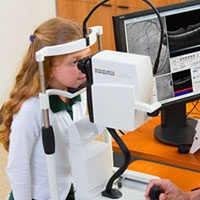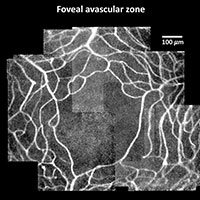Areas Of Focus
Occular Biology
The faculty in this area study the structure and function of the various components of the eye under normal and pathologic conditions. Cornea research topics include studies of normal cornea, corneal biomechanics, mechanisms of cornea wound healing, ocular surface inflammation and infection, meibomian gland disease, keratoconus, and ocular surface development. Retina research includes studies of normal function as well as pathologic and degenerative effects of specific diseases on the retina such as diabetes and glaucoma. Studies on the mechanisms and development of myopia focus on several components of the eye, including retina, sclera, and choroid. Ocular biology research in the college of optometry uses state of the art cell and molecular biology approaches including high-resolution imaging in vivo, in vitro, and in postmortem tissues as appropriate. These investigations are conducted in patients and in human subjects, as well as in animal models of eye disease in rodents, non-human primates, and zebrafish.


Visual Neuroscience
It is sometimes said that the eye is an extension of the brain. Our faculty research a variety of topics related to the visual neurosciences ranging from processing information in retinal circuits and various areas of the visual cortex, to circadian effects on function, how a decision to look in a certain direction is made and mechanisms underlying visual perception of the world around us. State-of-the-art approaches include neurophysiological recording techniques and use of optogenetics, 2-photon microscopy, visual psychophysical and behavioral testing paradigms, computational neuroscience approaches and imaging. In addition to human subject studies, rodent, non-human primate and zebrafish models for disease are employed in these investigations.
Clinical and Translational Research
Basic and clinician-scientists in the college of optometry research a wide range of topics with the common element of employing human subjects to investigate normal or abnormal vision. Research in this thematic area includes studies of monocular and binocular visual function in normal subjects, the pathologic effects of diseases and disorders that affect the eye and the central visual pathways, as well as development of interventions to prevent impairment or loss of vision. Some studies focus on disorders and diseases of the ocular surface, such as ocular allergy, meibomian gland disease, dry eye, and keratoconus. Other studies evaluate ocular complications caused by scleral lenses, and the effect of contact lens design on vision. Clinical researchers also study the early effects of prediabetes and progressive effects of diabetes on ocular structure and function. Studies in children examine effects of environmental and developmental factors on ocular structures using high resolution imaging in normal and myopic eyes. Clinical trials in children evaluate use of multifocal contact lenses to slow the progression of myopia, and various approaches to reduce effects of strabismus and amblyopia on visual function. Standard clinical assessments, and standard or newly developed psychophysical testing or electrophysiological evaluations are used in these studies as well optical approaches, including optical coherence tomography and adaptive optics imaging of retinal cell layers and vasculature.


Biomedical Optics
Optometry faculty use optical approaches to study the eye and effects of disorders that impact vision. Biomedical optics research includes the area of visual optics that focuses on the optical structures of the eye, the cornea and lens, ocular wavefront aberrations, eye growth and development of refractive error. The research also includes high-resolution imaging of the normal organization of the retina and optic nerve head and effects of aging and disease (diabetes, glaucoma or other) on the constituent cells and vasculature. Noninvasive optical approaches include adaptive optics imaging, optical coherence tomography, geometric and clinical optics. Other applied work in biomedical optics is focused on designing and manufacturing specialty contact lenses for patients with disorders of the cornea or lens.
Questions? Contact Us.
College Of Optometry
J. Davis Armistead Building
4401 Martin Luther King Blvd.
Houston, TX 77204-2020
uhco@central.uh.edu
(713) 743-2020
